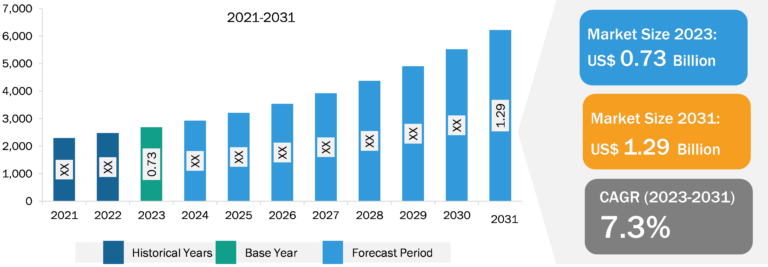
Preservative-Free Eye Drops Market
Preservative-Free Eye Drops Market: Key Insights
According to our new research study on “Preservative-Free Eye Drops Market Forecast to 2030 – Global Analysis – by Type, Application, Distribution Channel, and Geography,” the market is expected to grow from US$ 1,129.60 million in 2022 to US$ 1,587.66 million by 2030; the market is projected to register a CAGR of 4.3% during 2022–2030.
Preservatives are added to eye drops to prevent bacterial contamination. However, some people may show sensitivity or experience allergic reactions to these preservatives. Preservative-free eye drops are often recommended to people with sensitivities or those who need to use eye drops frequently. The preservative-free eye drops market report emphasizes the key factors driving the market and depicts the developments of prominent players. The growing awareness regarding potential side effects associated with preservatives and rising incidence of eye-related diseases (such as dry eye) among the geriatric population are the major factors contributing to the increasing preservative-free eye drops market size. However, the increasing number of product recalls hinders the market growth.

Rising Eye-Related Issues Associated with Aging Population to Drive Preservative-Free Eye Drops Market Growth
The rise in geriatric population in developed countries such as the US, the UK, and Japan, and developing countries such as China, India, and South Korea is driven by the modernization of healthcare facilities and developments in healthcare services, which has enhanced the life expectancy in these countries. According to the World Health Organization 2021 study, the population of people aged 60 and above is expected to grow from 900 million in 2021 to 2 billion by 2050. The share of the world population aged 60 or more would double from 12% in 2015 to 22% in 2050. The US Census Bureau states that the number of people aged 65 and above in the US is estimated to grow from 46 million in 2016 to 98 million by 2060. Moreover, the population share of people from this age group would increase from ~15% to ~24% during this period. As per the data published by the Fraser Institute, the share of Canada’s population aged 65 or older increased from 14% in 2010 to 19% in 2022, and it is further expected to reach 22.5% by 2030.
According to the United Nations (UN) Global Population Prospects for 2019 statistics, the global population is anticipated to rise by 2 billion in the next 30 years, along with a notable surge in the global geriatric population. As per the National Institutes of Health data, the global number of people aged 65 and above was ~703 million in 2019, ~9% of the global population, and it is further expected to double to 1.5 billion by 2050. Moreover, according to the data from the Pan American Health Organization, Brazil has over 30 million people aged 60 years and above, and by 2030, this age group is expected to reach ~50 million. As per the Brazil Statistical Institute, people aged 65 and above are expected to hold a 36% share of Brazil’s total population by 2050.
Aging is one of the prominent factors that weaken eye vision. As the degeneration process is much faster in elderly people, they are highly prone to eye conditions such as dry eyes. The primary causes of blindness and suboptimal vision in the US are age-related eye diseases. Dry eye syndrome is a chronic condition of the preocular tear film that damages the ocular surface, causing irritation and discomfort to the surface. It is typically characterized by tear film instability due to insufficient tear production or poor tear film quality, which results in increased evaporation of the tears. Failure of the eyes to produce and maintain sufficient tears to keep the eye’s surface lubricated results in multiple conditions varying from person to person.
According to the Centers for Disease Control and Prevention report, ~12 million people aged 40 years and above in the US had vision impairment in 2022. As per the “National Health and Wellness Survey,” conducted in the US in April 2020, ~16.4 million people were diagnosed with dry eye. According to Novaliq GmbH, currently, ~13 million Europeans and ~17 million Americans are diagnosed with dry eye disease. Therefore, a surge in the geriatric population, prone to various eye-related diseases, drives the preservative-free eye drops market growth.
Preservative-Free Eye Drops Market: Segmental Overview
The preservative-free eye drops market is segmented on the basis of type, application, and distribution channel. Based on type, the market is bifurcated into single-dose and multiple-dose. The single-dose segment held a significant share of the market in 2022. The same segment is expected to register a higher CAGR in the market from 2022 to 2030. The preservative-free eye drops that come in single-dose containers are safe for use with contact lenses. The single-dose containers help rule out the possibility of contamination with pathogens amid use.
Preservative-Free Eye Drops Market: Competitive Landscape and Key Developments
Nemera, Alcon Inc., Bausch & Lomb Incorporated, Eyekare Kilitch Ltd., Essex Bio-Technology Limited, Pillar5 Pharma Inc., Ivizia, Allergan PLC, CorneaCare Inc., and Bayer are a few of the key companies operating in the preservative-free eye drops market. These companies focus on product innovation strategies to meet evolving customer demands, along with maintaining their brand name in the market.
A few of the recent developments in the global preservative-free eye drops market are mentioned below:
- In May 2023, Thea Pharma Inc. launched the preservative freedom coalition to enhance awareness of unmet needs related to ocular surface diseases and point out the benefits of preservative-free topical ophthalmic medications. The initiative aims to assist eye professionals in understanding the necessity of choosing preservative-free alternatives to preserve the health of the ocular surface.






